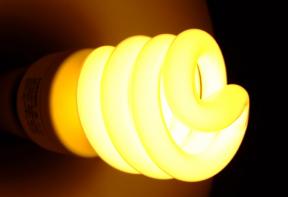12 ways to reduce your carbon footprint at home
Helping the environment is as easy as changing a lightbulb, and doesn't have to hurt your wallet
You don’t need to be a tree-hugging Luddite to have a positive impact on the environment. Here are 12 relatively simple, low-cost, big-benefit steps you can take to reduce your carbon footprint.
1. Low-flow toilets
How it works: Specially designed 6 l tanks use half as much water as standard toilets.
Cost: The same or even less than regular toilets
Eco-benefit: They waste less treated water than traditional toilets and help prolong the life of septic beds.
2. Rain barrel
How it works: Use a barrel to catch rain for watering plants.
Cost: Many municipalities offer subsidized barrels for less than $100.
Eco-benefit: Rain barrels reduce the risk of raw sewage going down the sewer; plants thrive on the warm, non-chlorinated water.
3. Low- or no-VOC paint
How it works: Reformulated paints minimize or eliminate the use of toxic volatile organic compounds (VOCs).
Cost: About $10 more per gallon than regular paint
Eco-benefit: Minimize smog-causing VOCs that off-gas for months after application in your home.
4. FSC-certified wood
How it works: Forest Stewardship Council (FSC) accreditation on building materials means that the trees were managed sustainably.
Cost: Lumber and plywood cost the same or 10 per cent more, at most, than non-FSC materials.
Eco-benefit: Your deck-building project won’t contribute to rainforest depletion.
5. Smart meters
How it works: Smart meters enable homeowners to track their energy use.
Cost: They’re about $500 to install. By 2010, all Ontario homes and small businesses will have one (the cost to be rolled into monthly billing). B.C. is following suit.
Eco-benefit: They encourage users to curb their energy use during high-demand periods.
6. When replacing appliances, buy Energy Star-rated models
How it works: Energy Star is a federal program that labels high-efficiency household products and tallies their consumption.
Cost: Often only incrementally more than non-rated appliances
Eco-benefit: Less energy consumption means lower greenhouse-gas (GHG) emissions and lower utility bills.
7. Change your lightbulbs to CFLs or LED lights
How it works: CFLs or LED lights use significantly less energy than incandescent bulbs and they have a much longer lifespan.
Cost: A typical CFL costs approximately $5. Look for multi-packs.
Eco-benefit: Natural Resources Canada estimates that if each Canadian household replaced one 60-watt incandescent bulb with a 15-watt CFL, national GHG emissions would be reduced by 396,000 tonnes.
8. Install a programmable thermostat
How it works: A programmable thermostat turns down the heating (or cooling) automatically when you’re away during the day or sleeping at night
Cost: Starts at about $50
Eco-benefit: According to Environment Canada, a 3ºC decrease will reduce a household’s annual GHG emissions by 1/2 tonne.
9. Add attic insulation
How it works: Heat rises, so it makes sense to stop it from leaking out your roof by adding insulation.
Cost: Easy-to-install batts of R-20 fibreglass insulation cost about $1/sq.ft.
Eco-benefit: A well-insulated attic also keeps your home cool in the dog days of summer, reducing AC usage.
Seal your cracks
10. Seal your cracks
How it works: Use caulking or foam to close off small openings that can add up to a basketball-sized hole in your wall.
Cost: A handful of $5 tubes of caulking, a can of $10 spray foam and an afternoon’s work.
Eco-benefit: The gaps around windows, doors and baseboards are a major source of heat loss.
11. Plant a windbreak
How it works: A strategically placed row of trees or shrubs can shelter your home from the prevailing winds.
Cost: You can pick up cedar shrubs for as little as $25 each–cheaper and offering more privacy than a fence.
Eco-benefit: Reduces winter heating costs, provides cooling shade in summer and traps carbon.
12. Change your furnace filters
How it works: Clogged filters force the furnace fan to work harder and, therefore, consume more electricity.
Cost: New filters are about $10 each. Check your owner’s manual for recommended frequency of replacement.
Eco-benefit: Filters also help air conditioners run more efficiently, so you’ll reduce energy consumption year-round.
To leave a comment, please log in












No comments